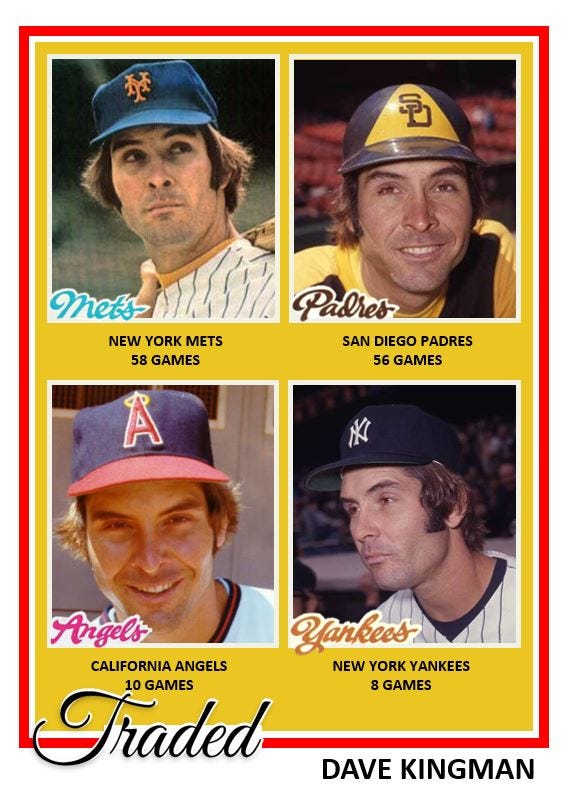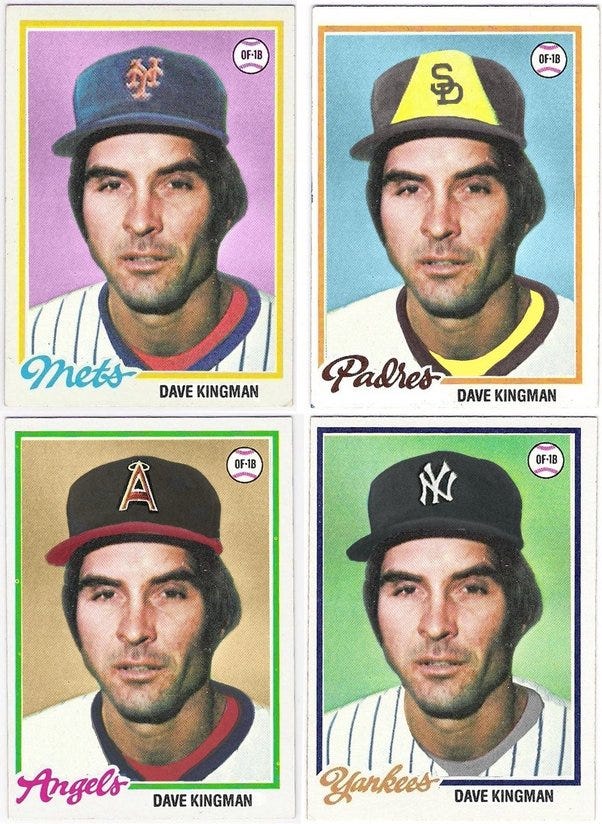Four Or More Teams In One Season
It’s unusual, but it does happen. Every once in a while you get a player who winds up playing for four or more teams in a season.
The most famous player to do so was Dave Kingman, who played for 4 teams in 1977:

Kingman started off the season with the Mets, but only managed to hit a hair or two above the Mendoza Line. Kingman was dealt to San Diego, was picked up off waivers by the Angels in September, and then was sent to the Yankees for the very end of the season.

You kind of wonder if Kingman couldn’t have saved the trouble and just taken the F train to the 5 to get to the Bronx.
The great irony, of course, is that Kingman wound up playing for yet another team in 1978: the Cubs. That’s where Kingman established himself as a good offensive player, tagging 28 home runs in 1978 and a whopping 48 in 1979.
Now, there have only been a few players who have managed to play for four or more major league teams in the same season. The most recent I’m aware of is Mike Ford, who spread his 27 base hits and 40 strikeouts in 2022 around four unhappy cities:
At least Kingman was able to hit for power!
Dave is the most recognizable name on the list of players who have played for 4 or more teams in a season:
If you do your research, you’ll notice that most of these guys are unusual cases:
Ford, mentioned above, was (and still is) a really bad hitter who didn’t do much with the glove.
José Bautista was 23 years old in 2004 — a promising youngster who was picked up in the Rule V draft and passed around like a hot potato his first season. The Orioles should have kept him.
Dan Miceli was a 32 year old middle reliever in 2003, and, to make matters worse, was a right handed pitcher, not left handed.
Dave Martinez was 35 years old in 2000 and clearly at the end of his career.
Mike Kilkenny was 27 years old in 1972, but was a poor starting pitcher and wasn’t much better in relief. He left the majors for good after putting up a 22.50 ERA in 2 innings of work for Cleveland in 1973.
Wes Covington was only 29 in 1961, but struggled to produce offensively no matter where he went. Covington held out at the beginning of that season for a higher salary, upset the Milwaukee Braves management, and didn’t find a permanent home until the Phillies decided to take a chance on him.
Ted Gray, a name I know well from my 1949 replay, was only 30 in 1955, but wound up with the worst season of his career, allowing 30 runs in only 23 1/3 innings pitched.
Paul Lehner is another familiar name from 1949. He wasn’t much of an offensive threat for the Browns that year, or, really for any team in his short career. He was bounced around at age 30 in 1951, and wound up going back down to Toronto after 5 plate appearances with the Red Sox in 1952.
Willis Hudlin was 34 years old in 1940 and seems to have lost the ability to pitch effectively, putting up a 6.98 ERA in 77 1/3 innings pitched. He came back with the Browns briefly in 1944, ostensibly because all the good pitchers were at war.
And, finally, Frank Huelsman hit .245 as a 30 year old rookie for four different teams in 1904. Huelsman actually had a good offensive season for the Senators in 1905. It seems that he was purchased by a minor league club after that season; I’ll have to do more research on him in another post.
There is one name missing from this list, by the way.
That would be Oliver Drake, who played for 5 teams in 2018 as a middle reliever. The 31 year old Drake allowed 29 runs in 47 2/3 innings and a WHIP of 1.448, which helps explain why he was pushed around from team to team. He was more effective with the Rays in 2019, but left the majors for good in 2020 after putting up a 5.73 ERA and a meager 74 ERA+ in 11 innings.
Now, if you’ve been paying attention, you’ll realize that most of these players have something in common. They were all extremely marginal players.
I suppose we could make an exception for Covington, who wound up being a key piece of the Phillies’ failed 1964 campaign. And then there’s the mystery of Huelsman, which will require more research.
Everybody else on this list, though, was basically a player who simply couldn’t make it work at the major league level. Even Bautista was likely called up a year too early, and almost certainly would have been better off playing with the Bowie Baysox, Baltimore’s AA affiliate at the time.
The only player here who was clearly not marginal was Dave Kingman.
I’ve written about Kingman’s 1977 season and its impact before, by the way. Read this if you haven’t yet:
Kingman was only hitting .209 when the Mets traded him, sure. But he did have 9 home runs to his name, and had shown the potential to do better in his good 1976 season. And Kingman was an All Star in 1976, for crying out loud. He’s not the sort of player you’d expect to see bounce from one team to another.
As a final note, Kingman is one of those players who would have fit in very well with the modern game. he struck out a lot, hit for low average, but always managed a high slugging percentage, and had good OPS+ numbers. His greatest failing as a player from a modern standpoint was his inability to walk — and taking pitches wasn’t exactly treated as a best practice in 1977.







> just taken the F train to the 5 to get to the Bronx
I don't know if you were just making things up for the fun of it, but neither of these lines served Shea Stadium nor Yankee Stadium
Huelsman's minor league page at baseball-reference.com is extensive and interesting.